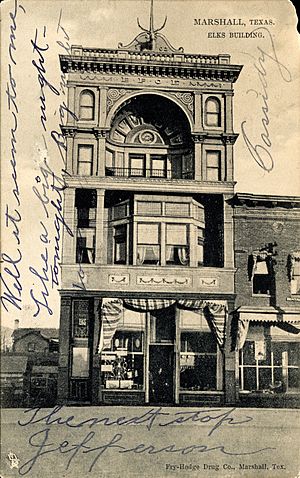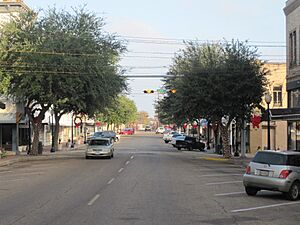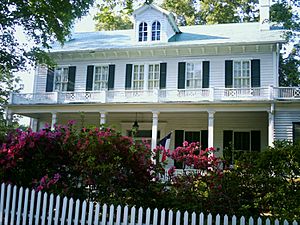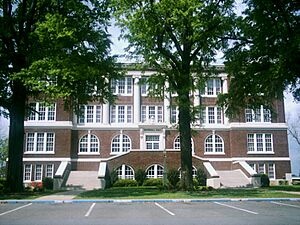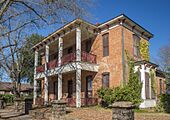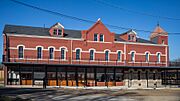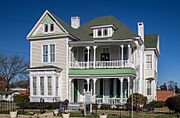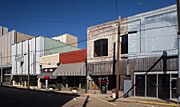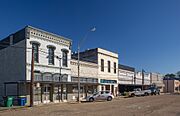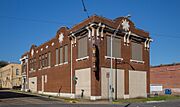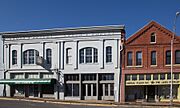Marshall, Texas facts for kids
Quick facts for kids
Marshall
|
|
|---|---|
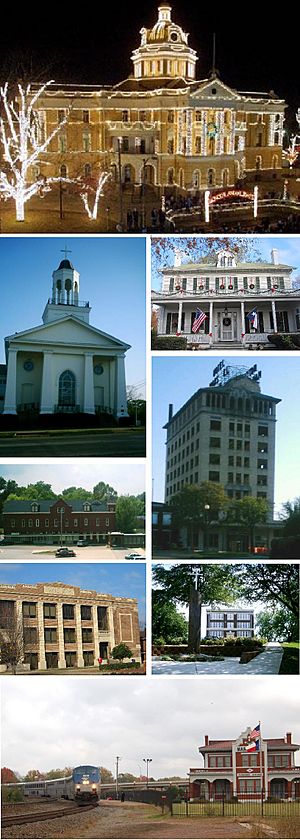
Clockwise: Old Courthouse, Starr Home, Hotel Marshall, ETBU, Depot, Wiley, Ginnocho, First United Methodist
|
|
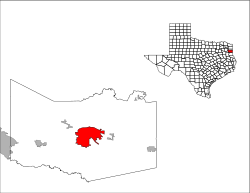
Location in the state of Texas
|
|
| Country | United States |
| State | Texas |
| County | Harrison |
| Founded | 1841 |
| Government | |
| • Type | Council-Manager |
| Area | |
| • City | 29.66 sq mi (76.81 km2) |
| • Land | 29.59 sq mi (76.65 km2) |
| • Water | 0.06 sq mi (0.17 km2) |
| Elevation | 341 ft (104 m) |
| Population
(2020)
|
|
| • City | 23,392 |
| • Density | 771.47/sq mi (297.86/km2) |
| • Metro | 65,631 |
| Time zone | UTC-6 (CST) |
| • Summer (DST) | UTC-5 (CDT) |
| ZIP codes |
75670-75672
|
| Area code(s) | 903, 430 |
| FIPS code | 48-46776 |
| GNIS feature ID | 2411041 |
Marshall is a city in the state of Texas, United States. It is the main city of Harrison County. Marshall is also a key cultural and education hub in the Ark-La-Tex area, where Arkansas, Louisiana, and Texas meet.
In 2020, about 23,392 people lived in Marshall. The larger Marshall area, which includes all of Harrison County, had about 66,726 people in 2018.
During the American Civil War, Marshall and Harrison County were very important for the Confederate States of America. This part of Texas had many large cotton farms. These farms used the forced labor of enslaved people. Harrison County had the most enslaved people in Texas. The city's wealth came from this forced labor and the cotton trade.
From the late 1800s to the mid-1900s, Marshall became a major railroad center for the Texas and Pacific Railway. After World War II, many African Americans in the city worked for social change. They were part of the Civil Rights Movement. They got a lot of help from the historically black colleges and universities nearby.
Marshall is famous for its "Wonderland of Lights" festival. This is one of the biggest light festivals in the U.S. The city also calls itself the "Pottery Capital of the World" because of its large pottery industry. Marshall has many nicknames, like "Cultural Capital of East Texas" and "City of Seven Flags".
Contents
Marshall's Rich History
Early Days and the Civil War (1841–1860)
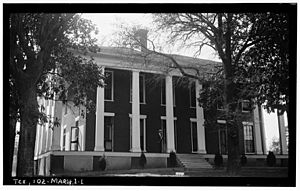
Marshall was founded in 1841. It became the main city for Harrison County. The Republic of Texas chose this spot because it had good water. The city was officially formed in 1843.
Marshall quickly grew into a major city. It was a "gateway to Texas" because many stagecoach lines passed through it. Later, one of the first railroads in Texas also came through Marshall.
Many colleges and schools were started here. This earned Marshall the nickname "the Athens of Texas." It was also the first city in Texas to have telegraph service. This connected Marshall to New Orleans.
By 1860, Marshall was the fourth-largest city in Texas. It was the center of the richest county. Farmers in the county owned more enslaved people than in any other county in Texas. Many white residents supported slavery and were against the Union.
During the Civil War, Marshall became a big supply center for the Confederacy. It made gunpowder for the Confederate Army. The city also hosted important meetings for Confederate leaders.
The government of Missouri, which was in exile, made Marshall its temporary capital. This is why Marshall got the nickname "City of Seven Flags." This name includes Missouri's flag and the six flags that have flown over the state.
Marshall also became the main office for the Confederate postal service. The city was likely a target for Union forces, but they were stopped before reaching it. Towards the end of the war, a lot of Confederate money and stamps were sent to Marshall. This suggests the government might have planned to move there.
Reconstruction and the Railroad Boom (1865–1895)
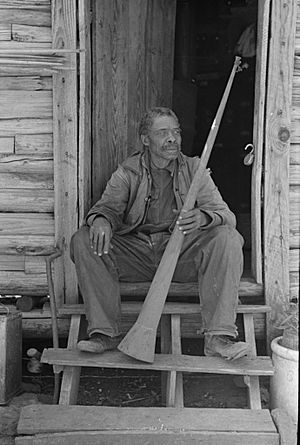
Union soldiers took control of Marshall on June 17, 1865. During the Reconstruction period, the city had an office for the Freedmen's Bureau. This group helped formerly enslaved people. Federal troops were also based here. In 1873, the Methodist Episcopal Church started Wiley College to educate freedmen. Many African Americans came to Marshall for new chances and safety.
After Reconstruction, a group called the White Citizens Party took control of the city. They used unfair methods to win elections. They forced many Union supporters, Republicans, and African Americans to leave town.
Despite these challenges, the African-American community kept growing. Bishop College, another historically Black college, was founded in 1881. Wiley College also became officially recognized in 1882.
Marshall's "Railroad Era" started in the early 1870s. The city offered land and money to the Texas and Pacific Railway. In return, the company built its main workshops and offices in Marshall. This brought many new jobs, and the city's population grew very fast.
By 1880, Marshall was one of the biggest cotton markets in the South. The railroad helped ship crops and other goods. New businesses opened, like J. Weisman and Co., the first department store in Texas. Marshall also became the first city in Texas to have electricity. Many beautiful historic homes were built during this time. The city's pottery industry began in 1895 with Marshall Pottery.
Even with this growth, some people in Marshall faced hardship. Black residents faced harsh unfair treatment under Jim Crow laws. These laws separated people by race. At the start of the 1900s, state laws stopped most Black and Hispanic people from voting. This meant they had no say in politics for over 60 years. They were also kept off juries, leading to unfair trials.
Marshall in the 20th Century
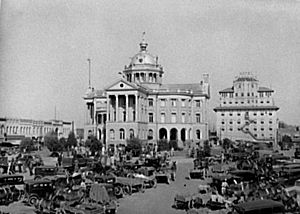
In 1909, a natural gas field was found near Caddo Lake. This provided gas for the city. The Texas and Pacific Railway became very successful in the first half of the 1900s. Marshall's pottery industry grew so much that it was called the "Pottery Capital of the World."
In 1930, a huge oil field was discovered near Kilgore. This brought more changes to the area.
During the early and mid-1900s, children of all races were forced to follow racial segregation laws. George Dawson, a Marshall resident, wrote about his childhood during this time. He learned to read at age 98. In his book Life Is So Good, he shared how he and other Black people sometimes resisted unfair rules.
As Black people were kept out of politics, tensions grew. Unfair killings of Black men, called lynchings, happened. These were meant to control the Black population. Between 1903 and 1917, at least 12 Black men were lynched in Marshall.
Marshall's historically Black colleges, Wiley and Bishop, were important centers for learning and culture. Famous writer Melvin B. Tolson taught at Wiley College. Painter Samuel Countee, a Bishop College student, became a successful artist.
Inspired by teachers like Tolson, students from these colleges started to fight against Jim Crow laws in the 1950s and 1960s. Fred Lewis, a leader in the National Association for the Advancement of Colored People (NAACP), helped overturn Jim Crow laws in Harrison County. Heman Sweatt, a Wiley graduate, sued the University of Texas at Austin Law School because they wouldn't let him in due to his race. The United States Supreme Court ruled that public universities in Texas had to allow Black students into their graduate programs. James Farmer, another Wiley graduate, helped organize the Freedom Rides. He also co-founded the Congress of Racial Equality (CORE), a major civil rights group.
Recent Times (Late 20th-Early 21st Centuries)
The Civil Rights Movement continued into the 1960s, 1970s, and 1980s. In the 1960s, students held the first sit-in protests in Texas at the county courthouse in Marshall. They protested against segregated public schools. The U.S. Supreme Court had already said this was illegal in 1954. Finally, in 1970, all Marshall public schools were integrated.
In 1970, Carolyn Abney became the first woman elected to the Marshall City Commission. In 1975, Sam Birmingham became the first African American elected to the commission. In the 1980s, he became the city's first African-American mayor.
Marshall's railroad industry began to shrink. Most trains switched to diesel fuel, and many lines merged. New highways and more air travel also led to fewer trains. The T&P workshops closed in the 1960s. Passenger train service stopped in 1970. The Texas oil crisis in the 1980s also hurt the local economy. Marshall's population dropped by about 1,000 people between 1980 and 1990.
For a while, many historic buildings in Marshall were torn down. People preferred new, modern buildings. But in the 1970s, the city started to focus on saving its historic places.
In 1976, Marshall was named an All-America City. In 1978, Marshall became a sister city with Taipei, Taiwan. Bill Moyers won an Emmy for his documentary about race relations in Marshall.
The city's economy faced challenges in the 1960s-1980s. Marshall started to focus on different industries, especially tourism. The city created new festivals, like the Fire Ant Festival and the "Wonderland of Lights." These joined the older Stagecoach Days festival. The Fire Ant Festival even appeared on TV shows.
The "Wonderland of Lights" became very popular. By 2000, the lighted dome of the Old Courthouse was a symbol of the city. In 2011, the festival celebrated its 25th anniversary.
In the 2000s, downtown Marshall started to grow again. Many important buildings were restored. Restaurants, shops, and apartments opened downtown. This made the area more lively. However, some historic homes outside of downtown still need repair.
The Sam B. Hall, Jr. Federal Courthouse in Marshall has handled many important legal cases. These cases often involve voting rights. For example, a case about Texas's new voting districts was heard here.
Marshall has also become known for many patent lawsuits. These are cases where companies sue over inventions. Many companies choose to file their lawsuits in Marshall. This is because juries here have a reputation for often siding with the company that filed the lawsuit.
In 2010, Dr. John Tennison shared his research. He found that boogie-woogie music started in the Marshall area in the early 1870s. It began with African Americans working for the T&P Railroad and in the logging industry. In May 2010, the Marshall City Commission officially declared Marshall the "Birthplace of Boogie Woogie."
Marshall's Location and Landscape
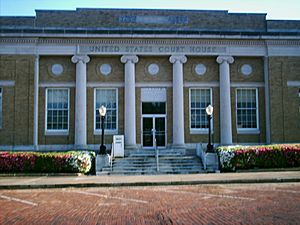
Marshall is about 150 miles east of Dallas. It is about 40 miles west of Shreveport, Louisiana. Marshall is actually closer to the capitals of Arkansas (Little Rock) and Mississippi (Jackson) than it is to Austin, the capital of Texas. Major roads like U.S. routes 59 and 80, and Interstate 20, pass through Marshall.
The city covers about 29.66 square miles. Most of this is land, with a small amount of water.
East End Boulevard (US 59) divides the city from north to south. US 80 divides the eastern part of the city from east to west. The Harrison County Airport is located south of Victory Drive.
West of US 59, you'll find older neighborhoods. North of Pinecrest Drive, the oldest part of the city spreads out over seven hills. This area centers around the Old Harrison County Courthouse. North of the courthouse is the Ginocchio National Historic District. This is where Marshall's Amtrak train station is.
Many old homes from the pre-Civil War and Victorian times are found around Rusk and Houston streets. West of downtown are some of the oldest African American neighborhoods in Texas, near Wiley College. North of Grand Avenue (US 80) are neighborhoods built by railroad workers. This area also has East Texas Baptist University and four historic cemeteries.
Marshall's Weather
Marshall has a humid subtropical climate. This means it has hot summers and mild winters. On average, Marshall gets about 51 inches of rain each year. Rain is spread out throughout the year.
In spring, severe weather can happen. Tornadoes have hit the city before. Summers are hot and humid. Temperatures often go above 86°F from June to September. The highest temperature ever recorded was 112°F in August 1909.
In 2008, Hurricane Ike brought strong winds to Marshall. About 82% of the city lost power for at least a day.
| Climate data for Marshall, Texas (1991–2020 normals, extremes 1893–present) | |||||||||||||
|---|---|---|---|---|---|---|---|---|---|---|---|---|---|
| Month | Jan | Feb | Mar | Apr | May | Jun | Jul | Aug | Sep | Oct | Nov | Dec | Year |
| Record high °F (°C) | 87 (31) |
90 (32) |
96 (36) |
97 (36) |
100 (38) |
106 (41) |
108 (42) |
112 (44) |
108 (42) |
101 (38) |
88 (31) |
85 (29) |
112 (44) |
| Mean daily maximum °F (°C) | 57.1 (13.9) |
61.5 (16.4) |
68.7 (20.4) |
76.3 (24.6) |
83.3 (28.5) |
90.2 (32.3) |
93.9 (34.4) |
94.2 (34.6) |
88.3 (31.3) |
78.3 (25.7) |
67.2 (19.6) |
58.9 (14.9) |
76.5 (24.7) |
| Daily mean °F (°C) | 45.1 (7.3) |
49.1 (9.5) |
56.2 (13.4) |
63.6 (17.6) |
71.7 (22.1) |
79.0 (26.1) |
82.3 (27.9) |
82.3 (27.9) |
76.0 (24.4) |
65.1 (18.4) |
54.7 (12.6) |
46.9 (8.3) |
64.3 (17.9) |
| Mean daily minimum °F (°C) | 33.1 (0.6) |
36.7 (2.6) |
43.7 (6.5) |
50.8 (10.4) |
60.1 (15.6) |
67.8 (19.9) |
70.8 (21.6) |
70.3 (21.3) |
63.8 (17.7) |
51.8 (11.0) |
42.1 (5.6) |
34.9 (1.6) |
52.2 (11.2) |
| Record low °F (°C) | −5 (−21) |
−13 (−25) |
12 (−11) |
26 (−3) |
38 (3) |
48 (9) |
52 (11) |
53 (12) |
35 (2) |
23 (−5) |
14 (−10) |
3 (−16) |
−13 (−25) |
| Average precipitation inches (mm) | 4.20 (107) |
3.98 (101) |
5.07 (129) |
4.78 (121) |
4.62 (117) |
4.66 (118) |
3.65 (93) |
3.05 (77) |
3.50 (89) |
4.67 (119) |
4.25 (108) |
4.91 (125) |
51.34 (1,304) |
| Average snowfall inches (cm) | 0.3 (0.76) |
0.4 (1.0) |
0.1 (0.25) |
0.0 (0.0) |
0.0 (0.0) |
0.0 (0.0) |
0.0 (0.0) |
0.0 (0.0) |
0.0 (0.0) |
0.0 (0.0) |
0.0 (0.0) |
0.0 (0.0) |
0.8 (2.0) |
| Average precipitation days (≥ 0.01 in) | 9.0 | 9.1 | 9.3 | 7.4 | 8.7 | 7.8 | 6.7 | 5.9 | 6.2 | 7.0 | 7.8 | 9.3 | 94.2 |
| Average snowy days (≥ 0.1 in) | 0.2 | 0.2 | 0.2 | 0.0 | 0.0 | 0.0 | 0.0 | 0.0 | 0.0 | 0.0 | 0.0 | 0.1 | 0.7 |
| Source: NOAA | |||||||||||||
People and Culture in Marshall
| Historical population | |||
|---|---|---|---|
| Census | Pop. | %± | |
| 1850 | 1,189 | — | |
| 1860 | 4,000 | 236.4% | |
| 1870 | 1,920 | −52.0% | |
| 1880 | 5,624 | 192.9% | |
| 1890 | 7,207 | 28.1% | |
| 1900 | 7,855 | 9.0% | |
| 1910 | 11,452 | 45.8% | |
| 1920 | 14,271 | 24.6% | |
| 1930 | 16,203 | 13.5% | |
| 1940 | 18,410 | 13.6% | |
| 1950 | 22,327 | 21.3% | |
| 1960 | 23,846 | 6.8% | |
| 1970 | 22,937 | −3.8% | |
| 1980 | 24,921 | 8.6% | |
| 1990 | 23,682 | −5.0% | |
| 2000 | 23,935 | 1.1% | |
| 2010 | 23,523 | −1.7% | |
| 2020 | 23,392 | −0.6% | |
| U.S. Decennial Census Texas Almanac: 1850–2000 |
|||
In 2020, Marshall had 23,392 people living in 8,229 households. About 26% of the people were under 18. About 16.4% were 65 or older. Almost 52% of the city's population was female.
In 2000, the average household had 2.55 people. The average family had 3.12 people. About 20.2% of the city lived below the poverty line.
Different Backgrounds in Marshall
| Race | Number | Percentage |
|---|---|---|
| White (NH) | 9,032 | 38.61% |
| Black or African American (NH) | 8,368 | 35.77% |
| Native American or Alaska Native (NH) | 81 | 0.35% |
| Asian (NH) | 197 | 0.84% |
| Pacific Islander (NH) | 5 | 0.02% |
| Some Other Race (NH) | 115 | 0.49% |
| Mixed/Multi-Racial (NH) | 600 | 2.56% |
| Hispanic or Latino | 4,994 | 21.35% |
| Total | 23,392 |
In 2018, about 40.2% of Marshall's population was white (not Hispanic). About 37.7% were Black or African American. About 18.8% were Hispanic or Latino.
Faith and Beliefs
More than 60% of Marshall's people are religious. The largest Christian groups are Baptists (39.3%) and Methodists (6.1%). The Roman Catholic Church is the third largest Christian group (5.6%). Other groups include Pentecostals, Presbyterians, and Lutherans. Less than 1% of Marshall's people are Jewish, Muslim, or follow Eastern faiths.
Marshall's Economy
Marshall has a varied economy. It includes services like insurance claims processing for BlueCross BlueShield of Texas. Education is also important, with several colleges. Manufacturing includes wood kitchen cabinets and pottery. Tourism is a big industry too, with about one million visitors each year.
Learning in Marshall
Schools for All Ages
The Marshall Independent School District serves the city. It has about 6,000 students across eight schools.
Trinity Episcopal School is a private school. It teaches students from preschool through eighth grade.
Colleges and Universities
More than 3,500 students attend colleges in Marshall every year. These include East Texas Baptist University, Wiley College, Texas State Technical College-Marshall, and Panola College-Marshall.
Wiley College is one of the oldest historically Black colleges in the U.S. The movie The Great Debaters was set here. It showed Wiley College's debate team fighting for racial equality. The real 1935 debate team, which included civil rights leader James Farmer, defeated the national champions from the University of Southern California.
Media and News
Marshall has one newspaper, The Marshall News Messenger. It is connected to the Longview newspaper. Marshall also has three radio stations.
Television News
Marshall has an ABC news office. The city can receive TV channels from Shreveport, Louisiana. These include ABC, CBS, FOX, NBC, The CW, My Network TV, and Louisiana Public Broadcasting.
The local cable company, Fidelity Communications, shows local football games and city meetings. Marshall also has a weekly podcast called "Beyond the Pine Curtain."
Radio Stations
Marshall shares its radio market with Longview.
Getting Around Marshall
Main Roads
- U.S. Highway 80
- U.S. Highway 59
- State Highway Loop 390
- Interstate 20
Marshall has two taxicab companies. The Harrison County Airport is also in Marshall.
Train Travel
Amtrak's daily Texas Eagle train stops in Marshall. You can take it to St. Louis and Chicago in the evening. In the morning, it goes to Dallas, Austin, and San Antonio. Three days a week, it continues to Los Angeles.
Places to Visit in Marshall
- Memorial City Hall, East Houston Street
- The Ginocchio/Harrison County Historical Museum, North Washington Street at Ginocchio Street
- Texas and Pacific Railway Depot, North Washington Street at Ginocchio Street
- Hotel Marshall (the tallest building in Marshall), 210 West Houston Street
- Starr Family Home State Historic Site, 407 West Travis Street
- Michelson Museum of Art, 216 North Bolivar Street
- Old Harrison County Courthouse, Whetstone Square
- Joe Weisman & Company (the first department store in Texas), 211 North Washington Street
Famous Landmarks
Notable People from Marshall
See Also
 In Spanish: Marshall (Texas) para niños
In Spanish: Marshall (Texas) para niños


